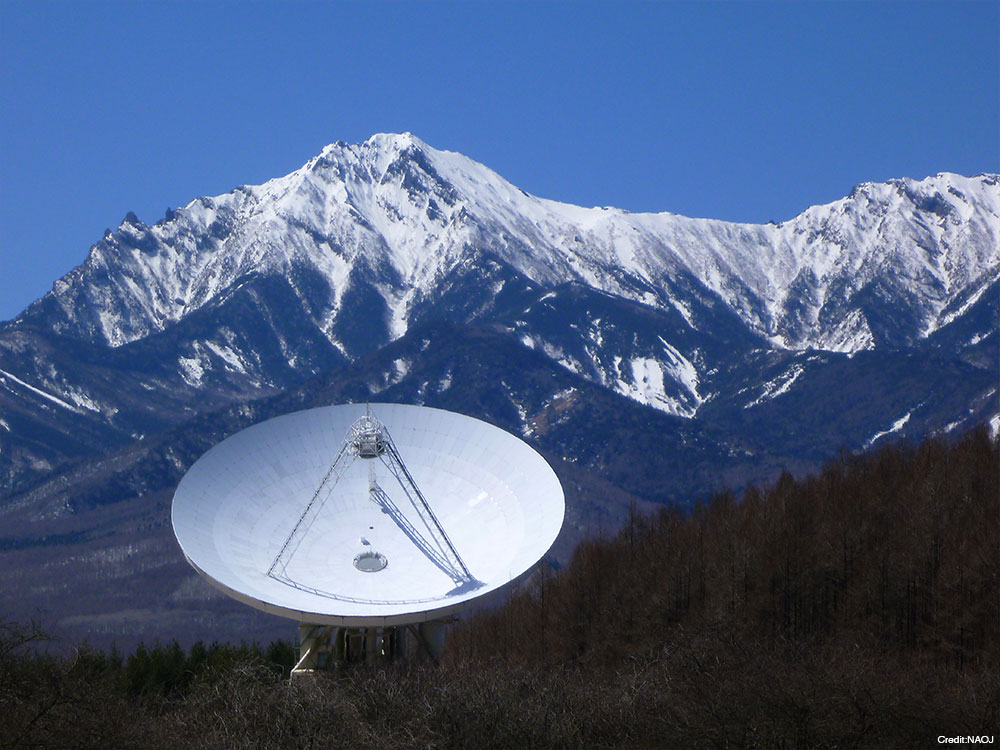What is the Nobeyama 45-m Radio Telescope?
The Nobeyama 45-m Radio Telescope, installed at Minamimakimura, Minamisaku, Nagano, boasts one of the world’s largest apertures for radio telescopes observing the radio waves known as “millimeter waves.” It has led Japanese radio astronomy since its completion in 1982. In particular, its research showing for the first time that a supermassive black hole exists in the center of a galaxy surprised the world.
Even today, more than 30 years since the start of observations, it is one of the world’s highest performance radio telescopes in the millimeter wavelengths around 3 millimeters. This shows how far the plan was ahead of its time. Technologies developed in the Nobeyama 45-m Radio Telescope are utilized in today’s telescopes such as ALMA.

Research
Utilizing the high sensitivity and high resolution of the Nobeyama 45-m Radio Telescope, we conduct a wide range of observations, from Solar System bodies and planetary atmospheres to protogalaxies at the edge of the Universe. The Nobeyama 45-m Radio Telescope has many observation modes. It is excellent at capturing the emission lines from the molecular gases constituting celestial bodies and excels at observing the composition, mass, and movements of those gases.
We have discovered many interstellar molecules and elucidated how the chemical composition of interstellar gas evolves, clarified the structures of galaxies and the circumstances of star formation, and achieve advanced results in a wide range of astronomy research.
Specifications
| Location | NAOJ Nobeyama (Nobeyama, Minamimakimura, Minamisaku, Nagano, Japan) |
|---|---|
| Prime manufacturer | Mitsubishi Electric Corporation |
| Antenna system | Beam waveguide optics |
| Antenna diameter | 45 meters |
| Surface accuracy of the mirror | 0.1 millimeter |
| Frequency | 1 to 150 gigahertz |
| Angular resolution | 0.004° (80/20 vision in terms of eyesight) |
| Characteristics | The Nobeyama 45-m Radio Telescope is one of the world’s largest single dish radio telescopes in the 100 gigahertz band. Besides being large, it has a state-of-the-art receiver that makes full use of semiconductors and superconducting technology, and boasts high sensitivity with world class observational performance in the 100 gigahertz band. |
History
| 1967 | The National Committee for Astronomy adopted a basic plan centered around a 45-m radio telescope. |
|---|---|
| 1978 | Nobeyama Radio Observatory established. Antenna construction started. |
| 1981 | Nobeyama 45-m Radio Telescope started test observations. |
| 1982 | Common use began for the Nobeyama 45-m Radio Telescope. |
| 2011 | Multi-beam receiver FOREST first-light. |
| 2016 | Certified as an IEEE Milestone. |
Related Project
Main Research Results
- Discovery of high-density gas disks around protostars such as L1551-IRS5
- Discovery of numerous interstellar molecules such as C3H, C6H, and CCS
- Discovery of high-speed H2O maser from galactic center nucleus of M106, confirmation of large mass black hole
- Nobeyama CO Atlas of Nearby Spiral Galaxies (Nobeyama Radio Observatory)
- Elucidating the Formation of Organic Material in the Universe: Expectations Increase for the Existence of Life in Other Planetary Systems (Nobeyama Radio Observatory, Japanese language only)
- Tail of Stray Black Hole hiding in the Milky Way
- Signs of Second Largest Black Hole in the Milky Way - Possible Missing Link in Black Hole Evolution
